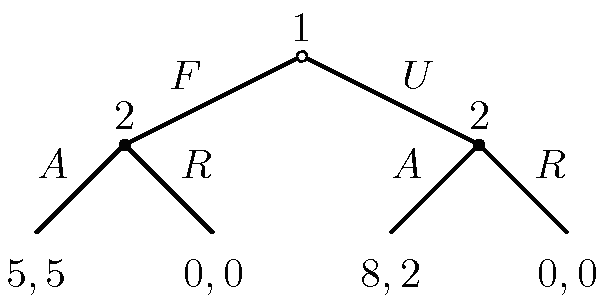
 |
AMERICAN KANG DUK WON KARATE |
Defining game theory
L.C. Thomas defines games as a theoretical model of conflict (Games, Theory and Applications, p.15). Game theory is a scientific study of strategy. Its objective is to look at a situation from each individual player, figure out each player's perspective and finally determine the consequences of these choices interacting with each other. Game theory isn't meant to show you how to play a game, instead, it gives the game theorist insight into what affects playing a game in a certain way will have on the outcome. The choices of your opponent will affect your strategy and vice versa. Therefore, in order to have an effective strategy, you have to take into account not only your interests, but the interests of all of the other actors in the game. Ideally, a person analyzing games would be able to discover the best outcome for the actors, but usually it is only possible to show that some strategies will not work (p.15-17).
Game theory vocabulary
actors/players - A player/actor is a unit that is involved in the conflict. I use the term unit because it does not have to be a single individual, an actor/player can be anything from a single person, to a group of people, or an entire country. They are grouped together because they share a single goal. For instance, when a company is bargaining with another company, each company is an actor because each individual employee has the shared goal of having their company be better off after the negotiations.
payoff - A payoff is the numerical value of the result for each player/actor. It's what we use to determine if the choices a player/actor made were the best ones he could have made, or if he should have done something different.
utility- a utility is a payoff that shows the fact that the players/actors have a preference between certain choices. After two utility outcomes have been given an arbitrary payoff that reveals the player/actor has certain preferences, the rest of the possible outcomes are restricted to certain values.
strategy - In the first section defining game theory, I used the word strategy. Strategy, for our purposes, is a representation of the choices he will make in response to anything that could happen during a game. Once, a player/actor decides on a certain strategy, he will already know what decisions to make regardless of the choices of his opponent or the results of chance.
This article will use the field of game theory to study the effects of discipline. While discipline can mean many different things to people we will give it a very specific definition to make it easier to study. For our purposes a person who is disciplined will make choices that will lead to the best outcome for a group of people instead of themselves.
Discipline is often said to make children better students in school, makes adults better citizens and everyone is a better person as a whole after becoming more disciplined than they were before. For this reason, discipline, and therefore the martial arts, applies to every aspect of a person's life. Why then doesn't every aspect of life emphasize discipline like Kang Duk Won? In my everyday life I have seen people regularly come to work or school late, litter, and just have a negative atmosphere around them. These people were never in Kang Duk Won and if they were to join they would either change or leave. Why is it so important to learn discipline when learning a down block or a center punch as apposed to everything else we do? It is emphasized because it makes the practitioners better fighters as well as better citizens. To show you how it does so we'll use the most famous game in game theory, called Prisoner's Dilemma.
| Prisoner B Stays Silent | Prisoner B Betrays | |
| Prisoner A Stays Silent | Each serves six months | Prisoner A serves ten years Prisoner B goes free |
| Prisoner A Betrays | Prisoner A goes free Prisoner B serves ten years |
Each serves two years |
In last years class I partnered you with another student and said you get fewer pushups if you confess about your partner, but if you both confess then you still will be required to do a lot of push ups. It was designed to simulate the above game. Here's how it works.
Prisoner's Dilemma
In the Prisoner's Dilemma, players A and B are crooks caught by the police. The police have enough evidence to give them a light punishment but if one of them confesses, they can give the other a heavy punishment. How do the police get them to confess?
What happens?
They take players A and B and put them in separate rooms. Then, tell both of them that they will receive a lighter sentence if they confess. Also, unknowingly to the crooks, if they both confess the police have no incentives to give them a deal. Without being able to communicate with each other, player A and player B will choose the option that is best for themselves. In this case, they both choose to confess. However, as you can see, it leads to a very different outcome than expected. Also, you will notice that neither player was influenced by the other's choice since they were unable to communicate with each other. When a choice is a better option for a player no matter what the other player chooses, it's called a dominate strategy. When a choice is never the best option no matter what the other player chooses, it's called a dominated strategy.
The Other Perspective
While no Kang Duk Won member would ever be a crook it's important to understand how they would solve this problem. It's actually a simplified version of problems faced in real world strategy. In the game, each player has a clear preference, but several things outside of their control affect the choices they make. First, they are unable to communicate with each other; therefore they both lack information about the other's strategy. This is called a game with partial (or incomplete) information. Also, both players must make their decisions at the same time. Neither player can wait and see what the results are of the other's strategy. This is called a simultaneous game. Other types of games are sequential, complete information or zero information. Each of these games has a different strategy needed to get the best outcome and some may not have a best outcome.
Solving the Dilemma
The Prisoner's Dilemma can be solved as long as it fit's one more condition. It has to be repeated an infinite number of times, or the players in the game can't know when the game will end. To illustrate this point, let's look at a prisoner's dilemma game repeated four times and both players' know that. In the game, the players would get the best overall outcome, if they cooperate instead of defecting on each other. Therefore, the strategy we follow should encourage each player to cooperate. To find the best strategy, theorists often use the saying, “look forward and reason back.” In other words, you look at each of the end results that could occur in the game, pick the best one and follow it all the way back to the beginning. In the real world this makes perfect sense. The phrase “hindsight is often 20/20,”is often used when talking about decisions people make. So, at the end of the game, neither player will have an incentive to cooperate because they will not be punished if they defect. This has a domino effect, making defecting the best outcome for both players every time. However, if the players do not know when the game will end, it creates the opposite affect. When each player is unsure how long the game will last they will be afraid to defect because if the game continues they will be punished.
Applying it to the martial arts
After reading about the Prisoner's Dilemma and the tit-for-tat strategy we can now begin to apply it to the martial arts. First, the prisoner's dilemma is similar to hostage situations, such as the terrorist hijacks on September 11th or even a severe accident scene such as car crashes or fires. It's in everyone's interest to attack the terrorist, rescue people from burning buildings, or help those hurt in a car crash, but every individual is better off if someone else does it. We can get around these problems in the real world by passing laws such as the Good Samaritan and also applying social pressure to help victims and to attack plane hijackers in mobs. Finally, but also most importantly, the self discipline you gain from your training allows you to overcome the problem created by the Prisoner's Dilemma. You are conditioned to respond to situations with the interests of a group in mind rather than your own. It might be worth moving in chunbi to scratch an itch or fix your belt, but in that case everyone has to do pushups. Since, your classmates are your friends and you wouldn't want to make them do pushups you don't act in your own interest and everyone benefits including you because you didn't have to do pushups. This training expands into your everyday life and when necessary, into life threatening situations.
Sequential Games, complete information
A sequential game is a game where each player takes turns making decisions instead of making them at the same time. Let's look at an example to see how the game is played differently. The diagram below is a sequential game mapped out in a form called a “game tree”.

This is a simple model where two actors make a choice between two strategies in a sequential order. Player 1 goes first and chooses between F and U, then Player 2 chooses between A and R. The outcomes of each strategy are the numbers given after player two makes his choice, the first number in the parenthesis is the outcome for Player 1 and the second is the outcome for Player 2. In this case, both players know the options and outcomes of their choices and their opponent's choices as well. Using the looking forward and reasoning back strategy, player 1 can see that player two will never choose R. Five, is a better outcome for player 2 than zero and two is a better outcome than zero. Therefore, player 1 can choose between an outcome of five and an outcome of eight. The outcome of this game will always be (8, 2) because player 1 can move first and knows the outcome of each move he makes. Player 2 is essentially helpless in this game.
Sequential Games, incomplete information
The game above is great news if your player 1, but what if you're player 2? If you're player 2, you need to change the game to one where player one does not know what the outcome of the game will be. In a single game, player two could hide the outcomes of the choices from player 1 somehow. In a repeated game, player 2 could also use what's called a mixed strategy. Usually in game theory, we use what's called the rationality assumption. This means that an actor will attempt to the best of their ability to get the best outcome for themselves. This is what caused the problem we faced earlier in the Prisoner's Dilemma. A mixed strategy however, will vary what outcomes they choose. If player 2 uses a mixed strategy, player 1can't be sure that player two won't pick choice R if he chooses choice U. In this case, player 2 has the upper hand over player 1.
Return to Black Belt Training Articles
